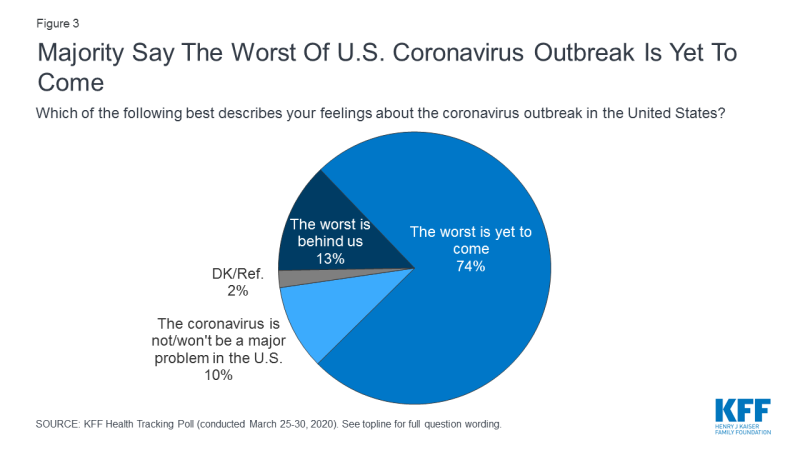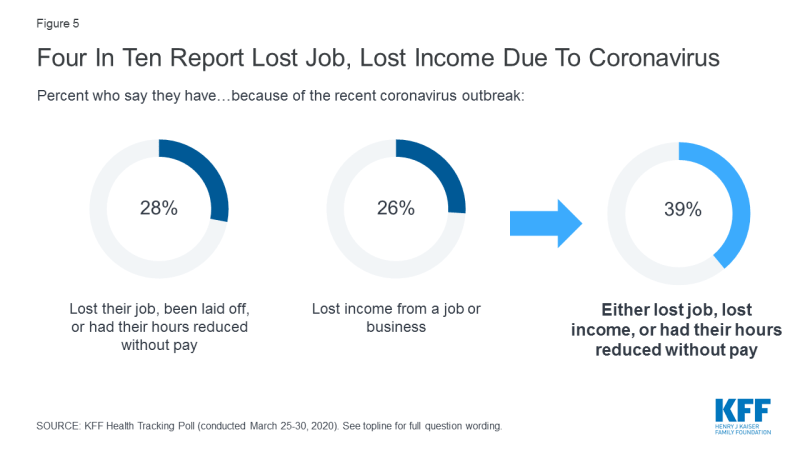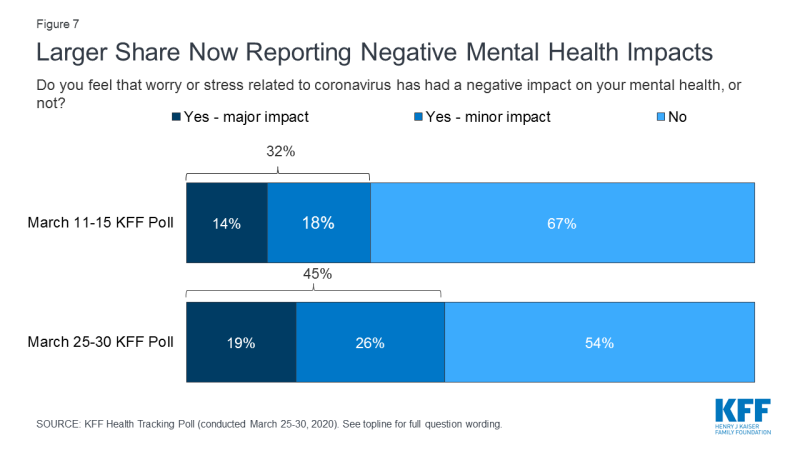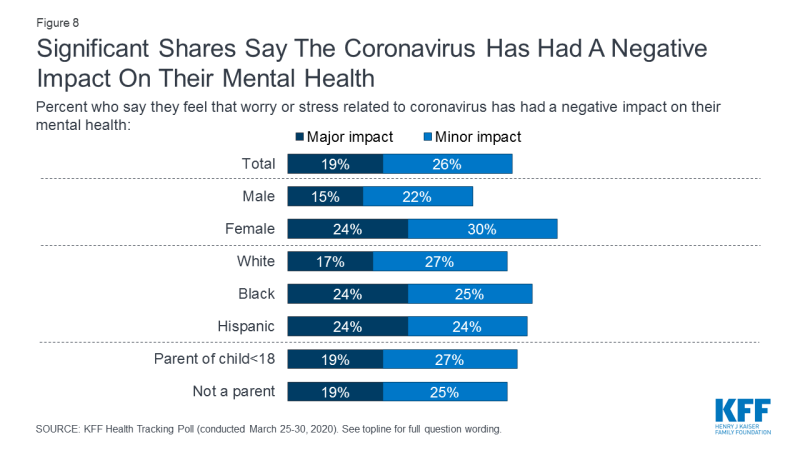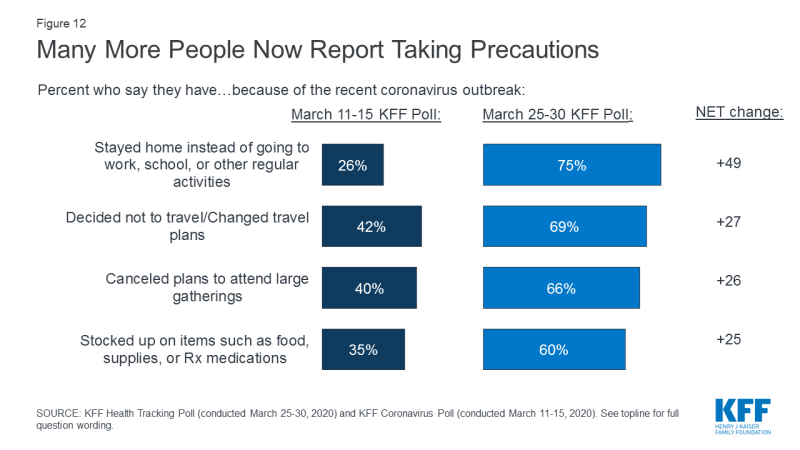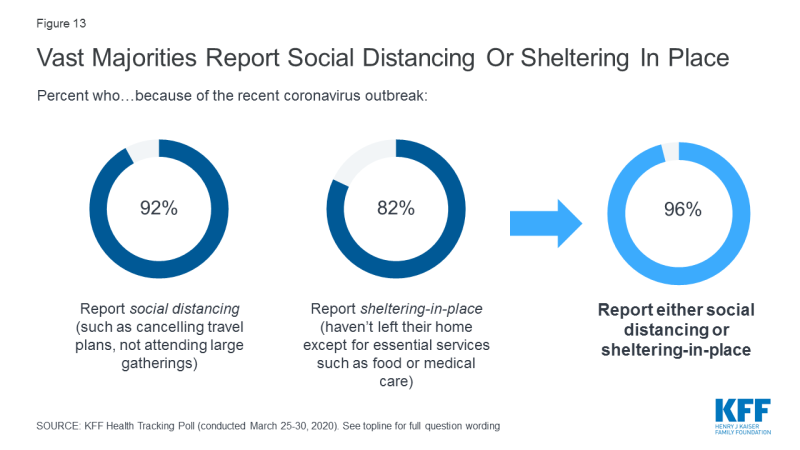KFF Health Tracking Poll - Early April 2020: The Impact Of Coronavirus On Life In America
Poll Findings: The Impact Of Coronavirus On Life In America
- As coronavirus cases in the United States continue to rise quickly across the country, and with sobering projections from the White House that even with mitigation efforts, deaths could top 100,000, the outbreak has directly or indirectly reached most people in America. The latest KFF Health Tracking poll, conducted March 25th – 30th, finds seven in ten Americans (72%) saying their lives have been disrupted “a lot” or “some” by the coronavirus outbreak. This is a 32 percentage point increase in the share reporting disruption in the KFF Coronavirus Poll conducted just two weeks prior. Partisan differences on this question found in the earlier poll have largely been erased, and in the current poll, large majorities of Republicans (70%), independents (72%), and Democrats (76%) say their lives have been disrupted. And most also report no end in sight with three-fourths saying “the worst is yet to come” when it comes to the coronavirus outbreak in the U.S., while few (13%) say “the worst is behind us.”
- An increasing share of the public report worrying about the economic impacts that coronavirus may have on their lives with more than half now reporting being worried that their investments will be negatively impacted for a long time (59%), they will be laid off or lose their job (52%), and nearly half worried they will lose income due to a workplace closure or reduced hours (45%). And while Americans increasingly worry about the impact on their own incomes, about half (53%) continue to be worried that they or a family will get sick from coronavirus.
- Nearly six in ten adults (57%) report being worried they will put themselves at risk of exposure to coronavirus because they can’t afford to stay home and miss work (up from 35% earlier in March). This includes six in ten hourly or workers who get paid by-the-job (61%) as well as seven in ten employed adults who earn less than $40,000 annually (72%). These workers are also disproportionately likely to be worried about losing income or being laid off or losing their job because of the coronavirus outbreak. Overall, 39% of adults say they have already either lost their job, lost income, or had their hours reduced without pay because of the recent coronavirus outbreak.
- The vast majority of the public, including majorities of Democrats, independents, and Republicans, say U.S. policy should be prioritizing the slowing down of the spread of the coronavirus rather than the U.S. economy. Eight in ten say “the U.S. should take measures aimed at slowing the spread of the coronavirus while more widespread testing becomes available, even if that means many businesses will have to stay closed.”1 Fewer, 14%, say “the U.S. should ease up on measures aimed at slowing the spread of the coronavirus soon, in order to open business and get the U.S. economy going again, even if that means more people would get coronavirus and could die.” On March 29th, 2020, President Trump announced the White House would be extending its social distancing recommendations and the closure of all non-essential businesses through April 30th.2
- The share of U.S. residents who report taking precautions or making preparations in reaction to the coronavirus outbreak has increased dramatically in recent weeks. Nearly all Americans – including large majorities across partisans and age groups – report they have either been taking social distancing measures such as deciding not to travel, cancelling plans, or staying home instead of going to work, school, or other activities (92%), or say they have been sheltering-in-place and not leaving home except for essential services such as food, medicine, or health care (82%).
Americans See Major Disruptions to their Own Lives, Report No End in Sight
The latest KFF Health Tracking poll, conducted March 25th-30th, while many cities and states were issuing public health guidance requiring social distancing or shelter-in-place measures, finds seven in ten Americans (72%) saying their lives have been disrupted “a lot” or “some” by the coronavirus outbreak. This is a 32 percentage point increase in the share reporting disruption in the KFF Coronavirus Poll conducted just two weeks prior. No group seems immune to the disruption by coronavirus with at least seven in ten men (70%), women (74%), black adults (70%), white adults (78%), parents (73%), and non-parents (72%) saying their lives have been disrupted.
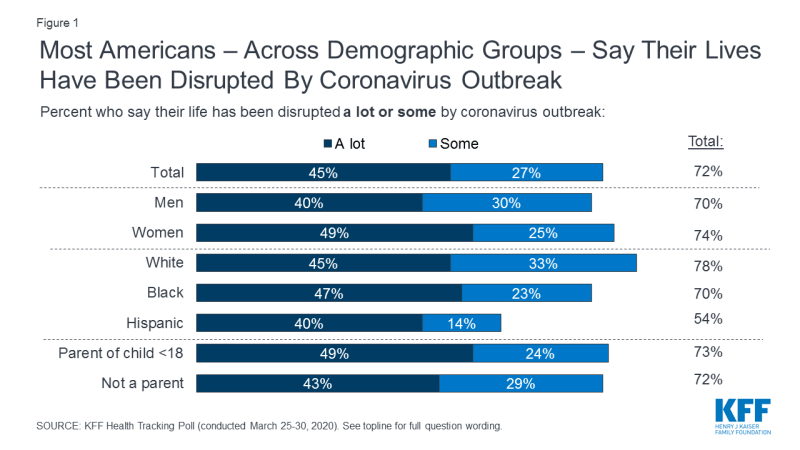
Figure 1: Most Americans – Across Demographic Groups – Say Their Lives Have Been Disrupted By Coronavirus Outbreak
Last month, there was a 19 percentage point difference in the share of Democrats who said their lives had been disrupted by the coronavirus outbreak (49%) compared to Republicans (30%). The most recent poll finds this difference almost entirely dissipated with at least seven in ten Democrats (76%), Republicans (70%), and independents (72%) saying their lives have been disrupted.
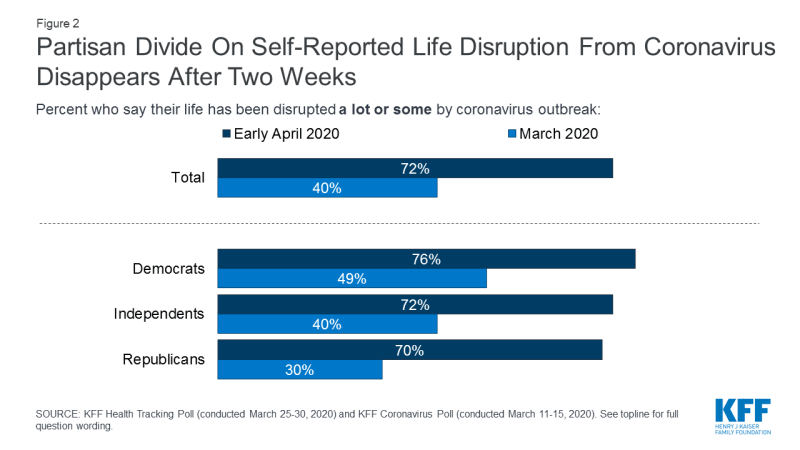
Figure 2: Partisan Divide On Self-Reported Life Disruption From Coronavirus Disappears After Two Weeks
Three-fourths (74%) of the public say “the worst is yet to come” when it comes to the coronavirus outbreak in the U.S. (up from 60% in an NBC News/Wall Street Journal survey conducted March 11-13), while few (13%) say “the worst is behind us.” Majorities of Democrats (82%), independents (77%), and Republicans (66%) all say the “worst is yet to come.”
Economic and Public Health Worries, Both Personal and For the Country Overall
Economic impacts and health impacts are both at the top the list when the public is asked about various potential impacts of coronavirus in their own lives and on the country more generally.
As coronavirus spreads across the country subsequently closing schools and businesses, the public is now feeling worried by both the impact that the outbreak may have on their own health as well as their personal financial situation. In the March 11th-15th KFF poll, the public’s top personal worry was about themselves or a family member getting sick (62% “very” or “somewhat” worried). The most recent poll now finds the public similarly worried their investments or savings will be negatively impacted for a long time (59%), they will be laid off or lose their job (52%), or they will lose income due to a workplace closure or reduced hours (45%), as they are about they or a family member getting sick (53%).
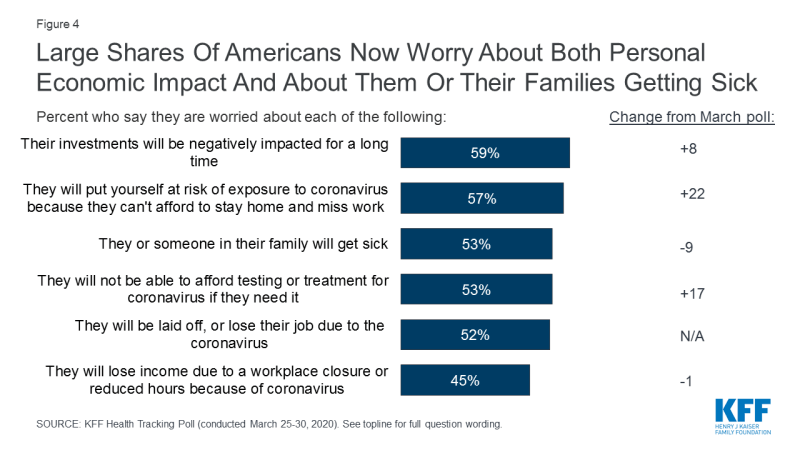
Figure 4: Large Shares Of Americans Now Worry About Both Personal Economic Impact And About Them Or Their Families Getting Sick
Six in ten (57%) also now report being worried they will put themselves at risk of exposure to coronavirus because they can’t afford to stay home and miss work (up from 35% earlier in March). This includes six in ten hourly workers (60%) and workers who get paid by-the-job (61%) as well as seven in ten employed adults who earn less than $40,000 annually (72%). Part-time, hourly, and lower-income workers are also disproportionately more likely to be worried about losing income or being laid or losing their job because of the coronavirus outbreak. To see more check out Economic Insecurity among Part-time, Hourly, and Lower Income Workers.
Many also worry that they will not be able to afford testing or treatment for coronavirus if they need it (53%, up from 36% two weeks earlier). Few (2%) report being tested for coronavirus with an additional 3% saying they have tried to get tested but have been unable to.
America’s Uninsured Population
Prior to the coronavirus outbreak in the U.S., there were already nearly 28 million people in the U.S. between ages 18 and 64 who did not have health insurance. While most of the uninsured have a full-time worker in their family, many report they do not have access to coverage through a job and some people, particularly lower-income adults in states that did not expand Medicaid, are ineligible for financial assistance to help pay for coverage. While Congress has provided some relief, this is limited to testing and is a state option.3 Among these includes almost 6 million uninsured people who are at high risk for a serious illness related to COVID-19.4 Overall, eight in ten (82%) uninsured adults ages 18-64 say they are worried about not being able to afford testing or treatment for coronavirus if they need it.
And while many Americans worry about losing their jobs or the impact coronavirus may have on their personal finances, four in ten (39%) say they have already either lost their job, lost income, or had their hours reduced without pay because of the recent coronavirus outbreak. This includes nearly three in ten (28%) of all adults who say they have already lost their job, been laid off, or had their hours reduced without pay and one-fourth (26%) who say they have lost income from a job or business because of coronavirus.
Significant shares of women (40%), men (37%), Hispanic adults (44%), black adults (42%), and white adults (36%), as well as nearly half (47%) of parents with a child younger than 18 years old report they have either lost their job, income, or had their hours reduced without pay.
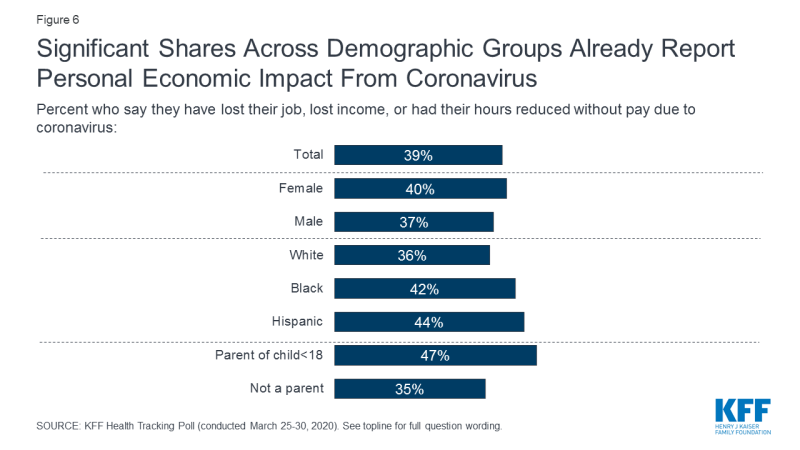
Figure 6: Significant Shares Across Demographic Groups Already Report Personal Economic Impact From Coronavirus
The share who report losing a job, income, or hours is similar across household income groups, including about four in ten of those with incomes under $40,000 (42%), between $40,000 and $90,000 (38%), and $90,000 or more (38%). While 42% of those under age 65 report losing a job, income, or work hours due to coronavirus, older adults are not immune from this problem, with 25% of those ages 65 and over reporting this experience as well.
People are also increasingly reporting that coronavirus is having a negative effect on their mental health. More than four in ten adults overall (45%) feel that worry and stress related to coronavirus has had a negative impact on their mental health, up from 32% in early March.
About one in five (19%) say it is has had a “major impact” including about one-fourth of women (24%), Hispanic adults (24%), and black adults (24%). Large shares across demographic groups report that worry or stress related to coronavirus has had a negative impact on their mental health.
PUBLIC WORRIES ABOUT LOCAL BUSINESSES AND AN ECONOMIC RECESSION
A majority of the public are worried that local businesses will close permanently because of the loss of revenue during the recent coronavirus outbreak in the U.S. (85%), and the U.S. economy will head into a recession (79%). Large majorities of Republicans (82%), independents (88%), and Democrats (89%) report being worried that local businesses will close permanently, as well as report being worried the U.S. economy will head into a recession (three-fourths of Republicans, eight in ten independents and 85% of Democrats).
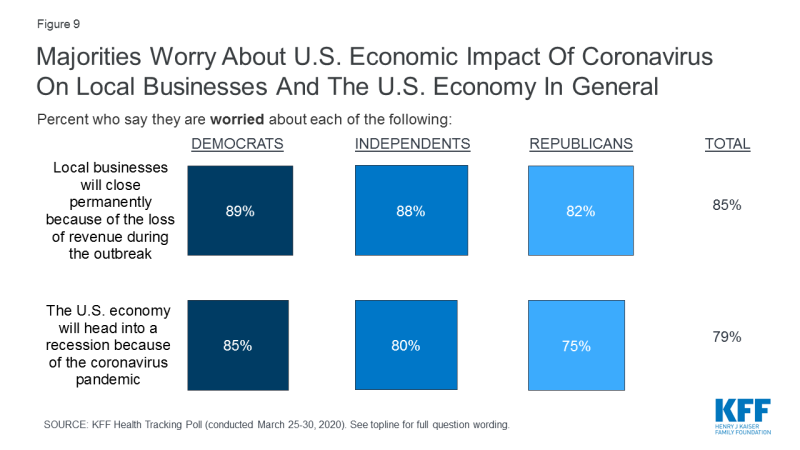
Figure 9: Majorities Worry About U.S. Economic Impact Of Coronavirus On Local Businesses And The U.S. Economy In General
Majorities Worry about Possible Impact on Nation’s Health Care System and Workers
Nearly nine in ten adults say they are worried that health care workers will not have the necessary personal protective equipment such as masks to protect themselves including 62% who say they are “very worried.” This is closely followed by 82% who are worried the country’s health care system will be overrun and people won’t be able to get needed medical care and 78% who are worried their local hospital will run out of necessary equipment like beds or ventilators to treat patients. A recent analysis conducted by KFF has found the coronavirus could overburden the U.S. health care system.
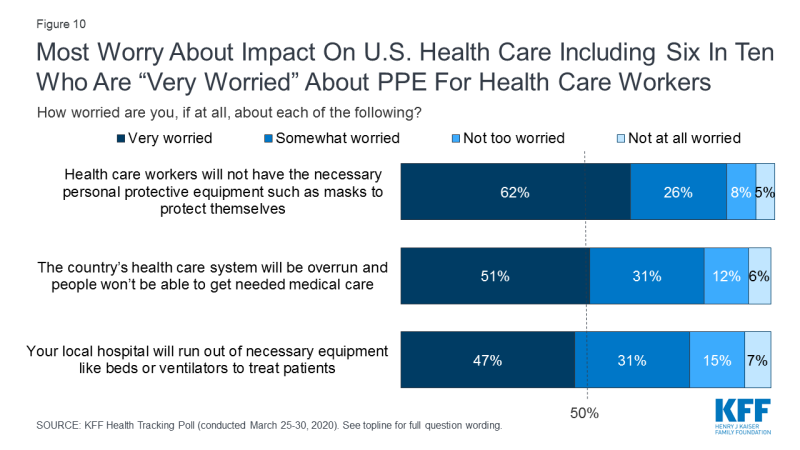
Figure 10: Most Worry About Impact On U.S. Health Care Including Six In Ten Who Are “Very Worried” About PPE For Health Care Workers
Health care workers, or those who live in households with someone who works as a health care provider, are also more worried (compared to non-health care workers) that they will put themselves at risk of exposure to coronavirus because they can’t afford to stay home and miss work (69%), or that they or someone in their family will get sick from coronavirus (64%). More than eight in ten of those who work in health care delivery or live with someone who does are also worried that health care workers, generally, will not have the necessary personal protective equipment to protect themselves (90%), the country’s health care system will be overrun (87%), and their local hospital will run out of necessary equipment (85%).
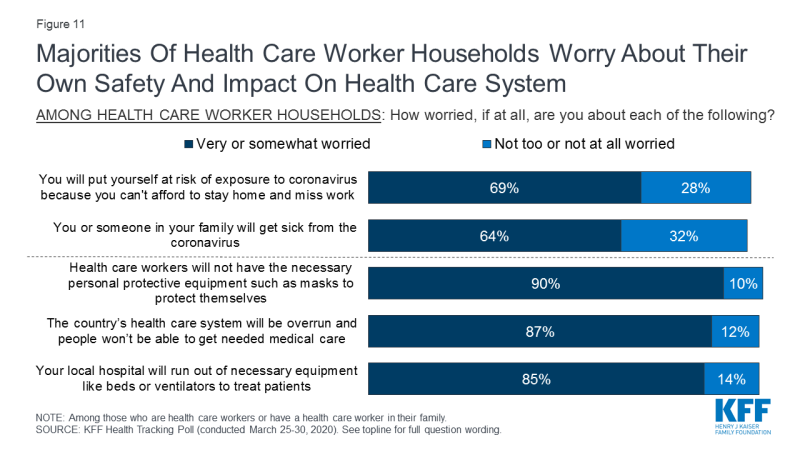
Figure 11: Majorities Of Health Care Worker Households Worry About Their Own Safety And Impact On Health Care System
Precautions and Preparations
The share of U.S. residents who report taking precautions or making preparations in reaction to the coronavirus outbreak has increased dramatically in recent weeks. Three-fourths say they stayed home instead of going to work, school, or other regular activities, a nearly 50 percentage point increase from two weeks ago. Seven in ten (69%) now say they have decided not to travel or changed travel plans, up from 42% earlier in March and 13% in the February KFF Health Tracking Poll. Two-thirds say they canceled plans to attend large gatherings (up from 40% earlier in March), and six in ten say they have stocked up on items like food, household supplies, or medications (up from 35% earlier in March).
Overall, nearly all Americans report that they have either been taking social distancing measures such as deciding not to travel, cancelling plans, or staying home instead of going to work, school, or other activities (92%), or say they have been sheltering-in-place and not leaving home except for essential services such as food, medicine, or health care (82%).
The KFF Coronavirus Poll conducted earlier in March found a large partisan divide in the share of adults reporting taking precautions in reaction to the coronavirus outbreak. While those divisions have abated somewhat in the new poll, they haven’t completely gone away. Democrats are still more likely than Republicans to report sheltering in place (90% vs. 74%) and stocking up on food, supplies, or medications (72% vs. 50%). But at least nine in ten Democrats (95%), independents (91%) and Republicans (91%) now report engaging in some form of social distancing.
| Table 1: Across Partisans, Nine in Ten Report Taking Precautions Because Of Coronavirus | |||
| Percent who say they have done each of the following because of the recent coronavirus outbreak: | Party ID | ||
| Democrats | Independents | Republicans | |
| Engaged in social distancing (NET) | 95% | 91% | 91% |
| Decided not to travel/changed travel plans | 75 | 68 | 65 |
| Stayed home instead of going to work, school, or other regular activities | 81 | 71 | 71 |
| Canceled plans to attend large gatherings | 71 | 64 | 63 |
| Sheltered in place, haven’t left their home except for essential services such as food, medicine, health care | 90 | 80 | 74 |
| Stocked up on items such as food, household supplies or prescription medications | 71 | 60 | 50 |
In the previous KFF Coronavirus poll, older people and those who live in a household where someone has a serious health condition were not more likely than other groups to report taking various precautions, even though they are among the groups most at risk of developing serious complications if infected with coronavirus. The most recent poll finds some indication that these at-risk groups are now taking precautions with more than eight in ten adults 60 and older overall (86%) and adults 60 and older with a chronic condition in the household (88%) reporting they have been sheltering in place, meaning they haven’t left their home except for essential services.
| Table 2: Taking Precautions Because Of Coronavirus By Age Group And Household Chronic Condition | ||||
| Percent who say they have done each of the following because of the recent coronavirus outbreak: | Total | Age 60 and older | ||
| Chronic Condition in HH | No Chronic Condition in HH | Chronic Condition in HH | No Chronic Condition in HH | |
| Engaged in social distancing (NET) | 92% | 92% | 90% | 88% |
| Decided not to travel/changed travel plans | 69 | 69 | 60 | 62 |
| Stayed home instead of going to work, school, or other regular activities | 74 | 77 | 76 | 76 |
| Canceled plans to attend large gatherings | 66 | 65 | 52 | 58 |
| Sheltered in place, haven’t left their home except for essential services such as food, medicine, health care | 78 | 87 | 84 | 88 |
| Stocked up on items such as food, household supplies or prescription medications | 59 | 62 | 52 | 60 |
MANY REPORT BEING UNABLE TO GET MEDICAL CARE, PRESCRIPTION DRUGS, AND HOUSEHOLD SUPPLIES
Substantial shares of people report being unable to get medical care unrelated to coronavirus or get different types of supplies as a result of the outbreak, including prescription medications. One-third of adults (34%) say they have been unable to get needed medical care unrelated to coronavirus as a result of the outbreak. Three in ten (29%) say they were unable to get groceries, 27% say they were unable to get cleaning supplies or hand sanitizer and one-fourth (24%) say they were unable to get prescription medications.
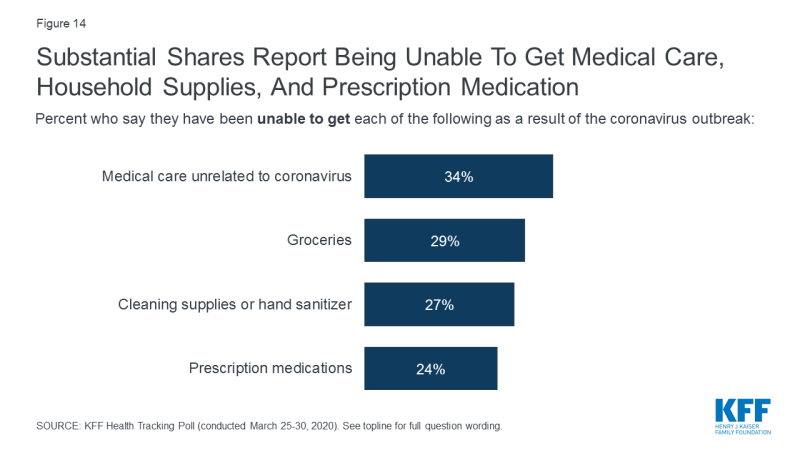
Figure 14: Substantial Shares Report Being Unable To Get Medical Care, Household Supplies, And Prescription Medication
What Should The Government Prioritize?
The vast majority of the public say U.S. policy should be prioritizing the slowing down of the spread of the coronavirus rather than the U.S. economy. Eight in ten say “the U.S. should take measures aimed at slowing the spread of the coronavirus while more widespread testing becomes available, even if that means many businesses will have to stay closed.”5 Fewer, 14%, say “the U.S. should ease up on measures aimed at slowing the spread of the coronavirus soon, in order to open business and get the U.S. economy going again, even if that means more people would get coronavirus and could die.” On March 29th, 2020, President Trump announced the White House would be extending its social distancing and shelter-in-place guidelines through April 30th.6
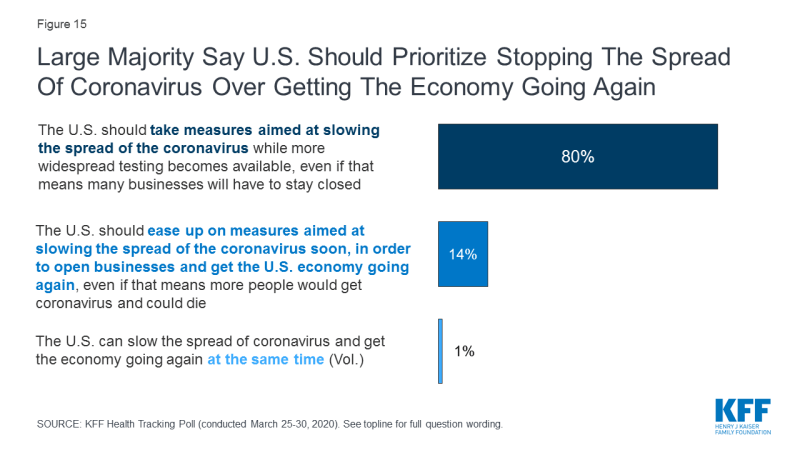
Figure 15: Large Majority Say U.S. Should Prioritize Stopping The Spread Of Coronavirus Over Getting The Economy Going Again
A larger share of Democrats (94%), independents (78%), and Republicans (68%) say the U.S. should prioritize slowing the spread of coronavirus than say the U.S. should prioritize growing the economy (4%, 16%, and 25%, respectively).
WHAT SOURCES DO AMERICANS TRUST FOR RELIABLE INFORMATION?
About eight in ten adults say they trust the U.S. Centers for Disease Control and Prevention (CDC) (83%) and Dr. Anthony Fauci (78%), the director of the National Institute of Allergies and Infectious Diseases who has been the dominant source of information from President Trump’s administration, for reliable information on coronavirus. This is closely followed by three-fourths (74%) who say they trust state government officials (74%) and seven in ten who trust the World Health Organization (WHO) as reliable sources of information. All of these sources are also trusted by a majority of Democrats, independents, and Republicans. Not quite half say they trust either the news media (47%) or President Trump (46%) to provide reliable information on coronavirus.
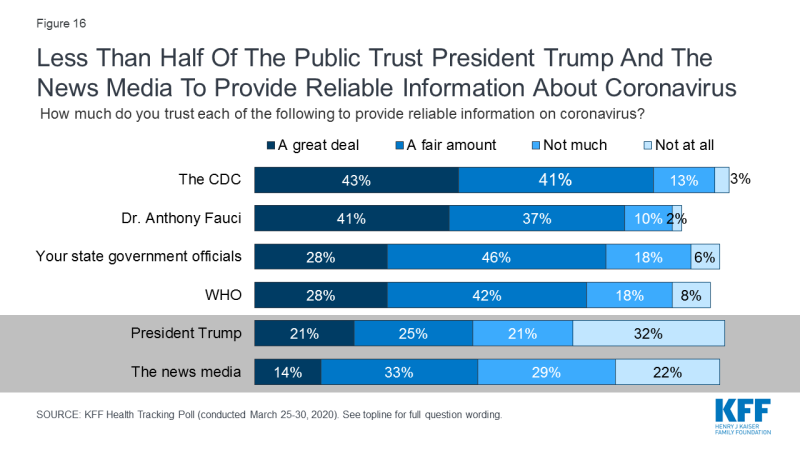
Figure 16: Less Than Half Of The Public Trust President Trump And The News Media To Provide Reliable Information About Coronavirus
While majorities across partisans trust the CDC, Dr. Fauci, state government officials, and the WHO, there are large partisan differences on trust for both President Trump and the news media to provide reliable information. The vast majority of Republicans (89%) trust President Trump to provide reliable information on coronavirus, compared to nearly half of independents (47%) and a small share of Democrats (12%) say the same. On the other hand, a majority of Democrats (63%) trust the news media to provide reliable information but fewer independents (40%) and Republicans (33%) say they do.
| Table 3: Trust In Sources of Coronavirus Information By Party Identification | ||||
| Percent who say they trust each of the following a great deal or a fair amount to provide reliable information on coronavirus: | Total | Party ID | ||
| Democrats | Independents | Republicans | ||
| The U.S. Centers for Disease Control and Prevention, or CDC | 83% | 86% | 81% | 90% |
| Dr. Anthony Fauci, the director of the National Institute of Allergies and Infectious Diseases | 78 | 80 | 76 | 77 |
| State government officials | 74 | 83 | 71 | 75 |
| The World Health Organization, or WHO | 70 | 82 | 70 | 57 |
| The news media | 47 | 63 | 40 | 33 |
| President Trump | 46 | 12 | 47 | 89 |
Economic Insecurity among Part-time, Hourly, and Lower Income Workers
With many businesses closing and many people experiencing symptoms of COVID-19, this month’s tracking poll also looks at the impact of coronavirus on America’s workforce including those who are employed either part-time or hourly. Overall, about half of workers (52%) say their employer offers them paid time off for when they are sick and for when caring for a sick family member. For more information on American paid leave policy, see Coronavirus Puts a Spotlight on Paid Leave Policies. But the share who report having paid time off is drastically different by types of employment. While the majority of full-time and salaried employees report getting both paid sick leave and paid family leave, fewer part-time workers (17%), hourly or contract workers (38%), and those earning less than $40,000 annually (37%) report the same.
|
Table 4: Many Part-Time, Hourly or Contract, and Lower Income Workers Do Not Get Paid Sick Leave Or Paid Family Leave
|
|||||||||
|
Total Employed
|
Hours
|
Compensation
|
Household income
|
||||||
|
Full-time
|
Part-time
|
Salary
|
Hourly/By the job
|
<$40K
|
$40 to <$90K
|
$90K+
|
|||
|
Percent who are offered both paid sick leave and paid family leave
|
52%
|
62%
|
17%
|
78%
|
38%
|
37%
|
56%
|
61%
|
|
|
Percent who are offered paid sick leave
|
69
|
78
|
34
|
89
|
57
|
53
|
75
|
76
|
|
|
Percent who are offered paid family leave
|
54
|
64
|
20
|
79
|
40
|
39
|
58
|
63
|
|
|
Percent who are not offered either paid sick leave or paid family leave
|
30
|
20
|
63
|
10
|
36
|
44
|
22
|
23
|
|
The KFF March Coronavirus Survey found 45% of employed adults say they could do “at least part of their job from home,” but a much smaller share of hourly or contract, part-time, or workers earning less than $40,000 annually said this was possible. This month’s KFF Health Tracking Poll finds at least half of all workers are worried about losing income due to a workplace closure (50%), being laid off or losing their job (52%), or putting themselves at risk because they cannot afford to miss work (58%). This includes nearly six in ten part-time workers and hourly or contract workers who report being worried about each of these things.
| Table 5: Employment-Related Worries Related to Coronavirus | |||||||||
| Hours | Compensation | Household income | |||||||
| Total Employed | Full-time | Part-time | Salary | Hourly/ By the job | <$40K | $40 to <$90K | $90K+ | ||
| Percent who are very or somewhat worried that they will… | |||||||||
| Lose income due to a workplace closure or reduced hours | 50% | 47% | 60% | 36% | 58% | 65 | 53 | 35 | |
| Be laid off or lose their job | 52 | 50 | 58 | 45 | 57 | 68 | 50 | 42 | |
| Put themselves at risk because they can’t afford to and miss work | 58 | 58 | 58 | 54 | 61 | 72 | 55 | 48 | |
| Percent who have experienced the following because of coronavirus… | |||||||||
| Lost income or lost their job, been laid off or had their hours reduced without pay (NET) | 42% | 38% | 54% | 35% | 45% | 45% | 41% | 41% | |
| Lost income from a job or business | 25 | 21 | 38 | 19 | 27 | 31 | 25 | 20 | |
| Lost their job, been laid off, or had their hours reduced without pay | 31 | 28 | 41 | 25 | 33 | 29 | 28 | 30 | |
Additionally, at least half of part-time workers (54%) and nearly half of hourly or contract employees (45%) say they have either lost their job or lost income because of coronavirus.
Endnotes
1 – At the time of the field period, more than half of U.S. states had issued “shelter-in-place” restrictions, subsequently closing non-essential businesses and limiting restaurants to carry-out and delivery purchases only. For more information on the various restrictions, see https://www.nytimes.com/interactive/2020/us/coronavirus-stay-at-home-order.html
2 – Trump extends federal social-distancing guidelines to April 30 after floating Easter deadline. USA Today. March 29, 2020. https://www.usatoday.com/story/news/politics/2020/03/29/coronavirus-trump-extends-social-distancing-guidelines-april-30/2937504001/
3 – Jennifer Tolbert, What Issues Will Uninsured People Face With Testing and Treatment for COVID-19? Kaiser Family Foundation, March 16, 2020. https://www.kff.org/uninsured/fact-sheet/what-issues-will-uninsured-people-face-with-testing-and-treatment-for-covid-19/
4 – Drew Altman, It may be time to waive patients’ costs for coronavirus treatment. Axios, March 19, 2020. https://www.axios.com/coronavirus-treatment-hospitals-cost-congress-waiver-9d1d69e7-d2ec-4457-b3a9-d4132422666d.html
5 – At the time of the field period, more than half of U.S. states had issued “shelter-in-place” restrictions, subsequently closing non-essential businesses and limiting restaurants to carry-out and delivery purchases only. For more information on the various restrictions, see https://www.nytimes.com/interactive/2020/us/coronavirus-stay-at-home-order.html
6 – Trump extends federal social-distancing guidelines to April 30 after floating Easter deadline. USA Today. March 29, 2020. https://www.usatoday.com/story/news/politics/2020/03/29/coronavirus-trump-extends-social-distancing-guidelines-april-30/2937504001/

